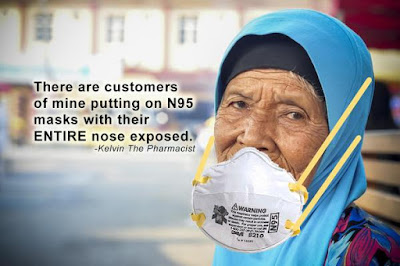
There is a band on or in the upper edge that is used to fit the mask around your nose. This stops any air leaks around the edges. Good respirator masks usually have 2 bands that go over your head so that they pull the edges of the mask close against your face. This means that the air you breathe in and out is filtered. When properly fitted to your face, a respirator mask forces all the air you breathe to go through the mask. Properly worn, a respirator mask gives you better protection against inhaling aerosols than a medical mask. They may not work well for children because their faces are smaller. Respirator masks do not work well on people with a lot of facial hair. They are usually white on the inside and the outside.įFP2, FFP3, N95 and KN95 are all types of respirator masks. If someone doesn't understand you, repeat what you said or phrase it differently - remember to use plain language.Respirator masks often have 4 layers of light, paper-like material.Use simple gestures, and sign language if known.

If the patient uses a hearing aid, make sure they are wearing their hearing aid and the battery is working.For patients who still have some hearing, make sure the environment is quiet and speak loudly and clearly.Write things down - use pen and paper, a white board, or text on device screens.Make sure you are facing the patient you are speaking to and speak clearly - avoid shouting, or speaking too fast or too slowly.If the patient is immunocompromised, ensure they are being seen in a well-ventilated environment. If a patient has hearing loss ensure a plan is put in place for how you are going to communicate with them - masks can be removed unless the patient has COVID-19 or other respiratory symptoms.This applies to both clinical and non-clinical staff, contractors and anyone else working on our sites. In most cases face masks are safe for anyone to wear, regardless of health conditions, and all staff working on hospital sites are now expected to wear face masks in certain areas or when with certain patient groups in our hospital buildings. Visitors must wear face masks to visit immunocompromised patients, if attending departments at the Churchill Hospital including Haematology, Oncology, Transplant, Chemotherapy, and Renal (including dialysis), if advised by Infection Prevention and Control (for example, visiting patients with COVID-19), or if they choose to. Patients may wear face masks through personal choice, but must wear face masks - if tolerated and safe - if they have symptoms of a respiratory infection or are attending departments at the Churchill Hospital including Haematology, Oncology, Transplant, Chemotherapy, and Renal (including dialysis). Tips for wearing face masks (pdf, 271 KB) Patients When you take it off to eat or drink, you should dispose of the old mask, wash or sanitise your hands, and replace it with a new one once you have finished eating. However, if your mask gets dirty, wet or damaged, or if you touch the inside of it, then you should change to a new one (following the steps above). There is no set time, nor recommended number of masks you should use each day. Use the ear loops to take the mask off and wash or sanitise your hands afterwards.Wash or sanitise your hands before taking it off.Avoid touching your face, or the parts of the mask that cover your nose and mouth.Tighten the loops or ties so it's snug around your face.Ensure the mask goes up to the bridge of your nose and all the way down under your chin.


when caring for a patient with symptoms of a respiratory infection.Our staff may choose to wear face masks, but they are no longer required to, apart from: If you are an OUH staff member and you need further information, please speak to your line manager or email Face masks in our hospitals Staff This area is for OUH staff only - please visit the NHS website for general information about Coronavirus (COVID-19).


 0 kommentar(er)
0 kommentar(er)
